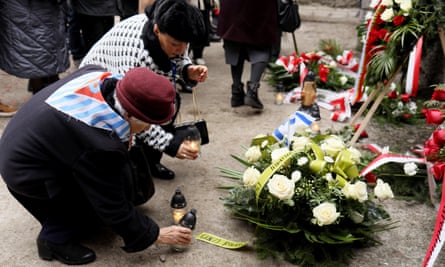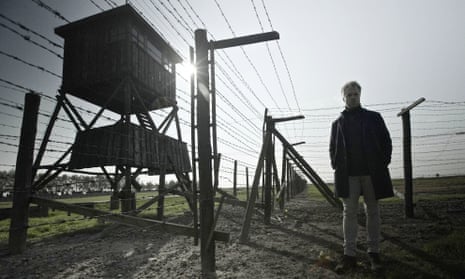I have been working around the subject of the Holocaust for more than a decade at the Imperial War Museum. But generally this has been at a distance, researching in archives and institutions. Working on the BBC documentary How the Holocaust Began, released this week ahead of Holocaust Memorial Day, changed that. It took me to forgotten places, sites where historical details are still unknown and mysteries remain.
There are still mass killings and mass graves about which we know little. Discovering this, and integrating it with the broader history I know, was a profound experience.
There can be a tendency sometimes to think of the Holocaust in very singular ways. It seems to be assumed that Hitler’s warped and abhorrent intentions were seamlessly translated into practical action by a cabal of loyal followers and enforced in purpose-built “camps”. There is also a sense that it was systemisation and bureaucratisation more than individual agency that propelled this process forward once it had begun. This idea is not only inaccurate; I think it’s dangerous.
The Holocaust did not happen simply because Hitler willed it into being, but because there were enough people prepared to act on his intentions and align themselves with his ideology. It was not implemented as part of a preconceived masterplan that had always anticipated death camps as the ultimate destination; it evolved.
The process by which this happened demanded effort, thought and consideration. Moreover, it required huge numbers of people – not just thousands, or tens of thousands even, but hundreds of thousands. These people gave Hitler the practical means to achieve his ideological vision. Hundreds of thousands of men and women who cooperated, in various ways, with the mass murder of 6 million men, women and children.
For years it has been suggested that the people responsible for this were either acting on orders that they had no choice but to follow, or were so brainwashed they had no meaningful understanding of what they were doing. I have found very little evidence to suggest that this is the case. Indeed, what shocked me most about some of the accounts I heard while filming was not just how much collaboration and compliance there was, but how readily this was offered. The path to genocide did not seamlessly unfold in front of those who walked along it: they had to build it for themselves.
From the very first shootings at the beginning of the German invasion of the Soviet Union on 22 June 1941, those on the ground did not wait for orders from Berlin to determine action – they used their own initiative.

Hitler’s Wehrmacht forces were followed into the Soviet Union by four specially assembled SS units called Einsatzgruppen. These units were given instructions to identify and eliminate Hitler’s political enemies. Initially, their primary focus was Bolsheviks, but under the tenets of Hitler’s belief that Bolshevism was a Jewish conspiracy, this swiftly evolved to encompass all Jews.
Visiting the site of one of these first acts of mass murder at the Lithuanian town of Gargždai was a sobering experience. In the years since the war, housing has built around the place where Lieutenant Hans-Joachim Böhme ordered 200 Jews to be shot on the afternoon of 24 June 1941. Today there is a memorial, but it is hard to find. All remnants of the Jewish community who lived on the site are gone.
Gargždai speaks to the foundational moments where the Nazis’ violent persecution of Jewish people became explicitly murderous. Those killed were not the first Jewish people to die at the hands of the Nazis, but they were some of the first to be murdered in the pursuit of a policy that would become unequivocally annihilatory.
In the weeks that followed, the scale of this mass murder grew substantially, and in less than a month the targets of the Einsatzgruppen had moved on from military aged men to include women and children. By the end of the year more than a million men, women and children had been killed.
While we have some degree of knowledge – albeit incomplete – about the deportations to death camps that ultimately followed, the history of those who were walked to their places of murder is far less clear. There is still no certainty about the total numbers involved. This lack of clarity isn’t helped by present-day populations who are often extremely reticent about dealing with – or even acknowledging – the historic crimes. I had heard about this before, but being confronted with it first-hand was chilling.
In recent years, pioneering geophysicists and archaeologists have started to address this gap. By using their expertise to identify where some of the lost bodies might be, they are able to reveal something about what happened in these places, as well as to provide some degree of closure.
Until recently I had been unaware of the number of these remaining mass graves. Knowing that from 1942 the Nazis embarked on a programme to disinter and destroy the remains within them, as part of a desperate attempt to conceal their crimes, I had naively assumed little was left. I was wrong.
I was confronted with this in a direct way in a small wood on the edge of the Lithuanian town of Alytus. A few hundred yards from the carpark, Harry Jol and Phil Reeder – two of the geophysicists working with us on the programme – identified an unmarked grave. A small number of historic accounts indicated that shootings had been conducted at the site, but details were sketchy. The research conducted by Jol and Reeder’s team revealed that not only was there a pit where these accounts suggested one could be found, but it was far larger than anticipated. In fact, their scans suggested that beneath the damp and sun-dappled earth were tens of thousands of bodies.
It is a terrible reality, but just feet beneath forests, fields and beaches across eastern Europe are human bones. These acts of mass murder have little, if nothing, to do with the perception of the Holocaust as a product of systemised process. If anything, they are a more accurate reflection of its true, barbaric character.
This is the ground the camps were figuratively built on. The fact that such a place – a mass grave of potentially tens of thousands – could exist, unmarked and unexplored in a modern European nation, is a profoundly disturbing thing. I believe, however, that it is something we need face up to.
James Bulgin is head of public history at Imperial War Museum, London, and previously head of content for the Holocaust galleries at the museum
How the Holocaust Began is available to watch on BBC iPlayer
Do you have an opinion on the issues raised in this article? If you would like to submit a response of up to 300 words by email to be considered for publication in our letters section, please click here.

